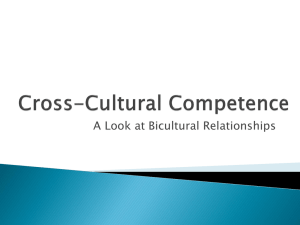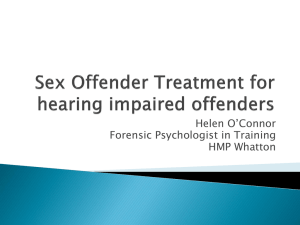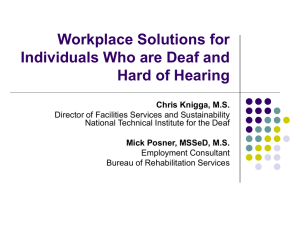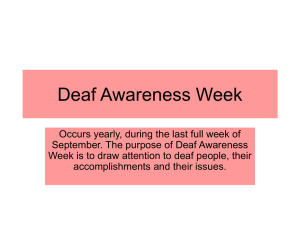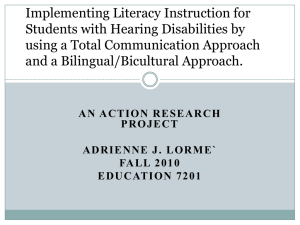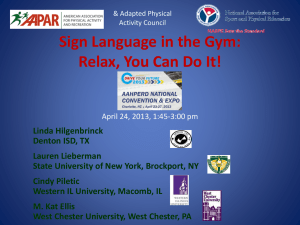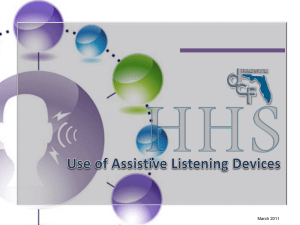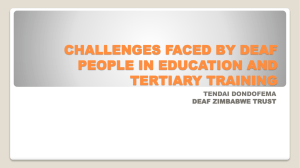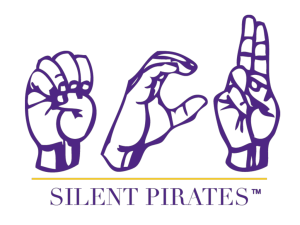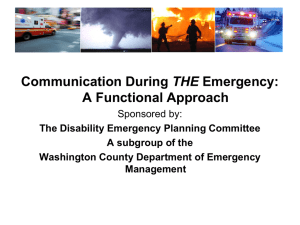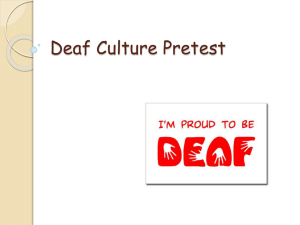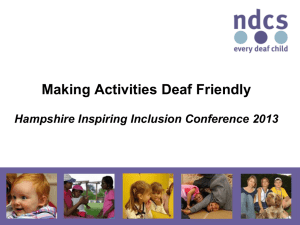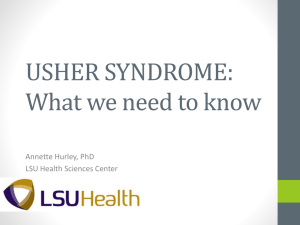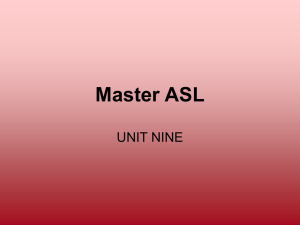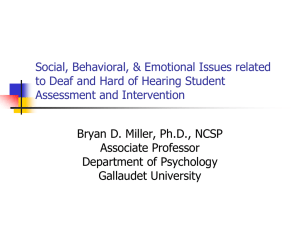Deaf and Hard of Hearing People
advertisement
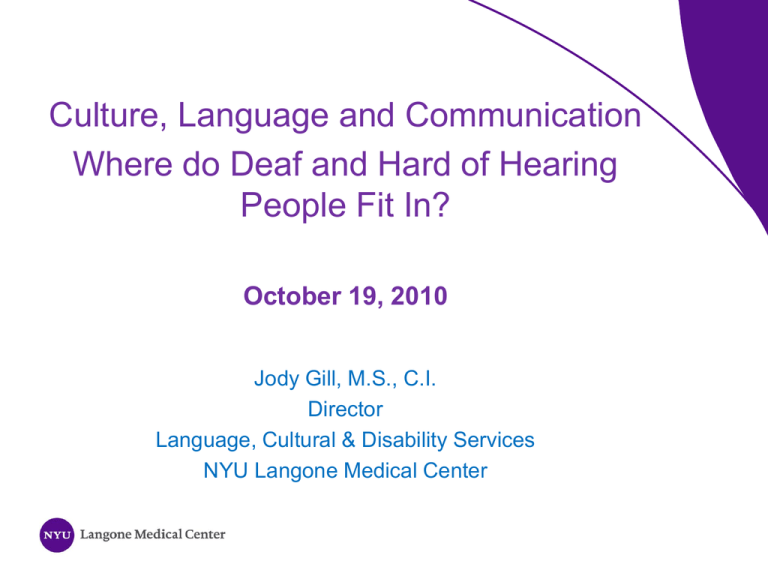
Culture, Language and Communication Where do Deaf and Hard of Hearing People Fit In? October 19, 2010 Jody Gill, M.S., C.I. Director Language, Cultural & Disability Services NYU Langone Medical Center Statistics • Over 36 million deaf and hard of hearing people in America • 30-40% of the population 65 y/o and older have some type of hearing loss • *300,000 to 500,000 sign language users in U.S. • 5 in every 1,000 babies born deaf • Over 90% of deaf children have hearing parents “Facts about Hearing Loss.” Center for Hearing and Communication. June 2010 *no definitive numbers have been verified Deaf vs. deaf…what’s the difference and why is it important? deaf means “loss” of hearing Deaf means culture, language, “deaf world”. Disability is a label attributed suggesting one needs help, services, rehabilitation, cures, personal assistance. Deaf people are not asking for these interventions or services. Myths that continue … 1985 – “Profound deafness that occurs prior to the acquisition of verbal language is socially and psychiatrically devastating.” Another “authority” on deafness states: “Suspiciousness, paranoid symptomatology, impulsiveness, aggressiveness have been reported as typical of deaf adults…” “The deaf are more impulsive and aggressive than the hearing, they have deficiencies in language skills, their intellectual development is delayed…” Eugenics, Oppression and Audism • Eugenics - Alexander Graham Bell believed that deaf people should not marry other deaf people to avoid more deaf babies being born. Sterilization – movements in the 20th century in the U.S. and Germany to see voluntary sterilization • Oralism – To be able to speak means to be human. Speaking equates with hearing. • Audism – “The notion that one is superior based on one’s ablity to hear or behave in the manner of one who hears.” (Humphries 1977) • “Like racism and sexism, audism insists that inherent biological factors determine individual traits and capacity” -- Harlan Lane -- Colonization “Whenever a more powerful group undertakes to assist a less powerful one, whenever benefactors create institutions to aid beneficiaries, the relationship is fraught with peril.” -Harlan Lane – “The Mask of Benevolence”, The Colonization of African and Deaf Communities. 1992 It’s not just about language, it’s about communication. It’s not always about disability, it’s about culture. Collective shared experiences Language Historical perspective Storytelling and narrative Practices and beliefs Customs, rituals, traditions What do we know about cultural humility? We need to understand, respect and recognize: Collective shared experiences Language Historical perspective Storytelling and narrative Practices and beliefs Customs, rituals, traditions ADA and Title VI • • • • Americans with Disabilities Act (1990) Rehabilitation Act of 1973 Title VI of the Civil Rights Act (1964) The Joint Commission - Incorporating all guidelines to meet CLAS standards Medical model of hearing loss Late deafened Hard of hearing Situational hearing loss Specific etiologies (NF2) Communications needs vary…again, it’s not about language! Auxiliary aids and services… • • • • • Lip-reading Hearing aids Cochlear implants Speech therapy Auxiliary aids and services (amplified handsets, etc.) • Written communication Does our Cultural Competency Training include Deaf people? • • • • What do we need to know? Whom do we ask? What do we know about sign languages? What about the immigrant or refugee who is Deaf? What are their language/communication needs? Health Literacy…where do Deaf people fit in? • What do we understand about the literacy and health literacy levels of deaf and hoh people? • What do we know about written communication and many Deaf people? • Why can’t we just give a Deaf patient a consent form to read? Considerations… • How do we ensure effective communication? • How and where do we document services provided? • What sort of cultural adjustments do we need to make? • How do we incorporate these populations into our education and training? What do we know about effective communication? • • • • • • • Fewer visits to an Emergency Department Fewer re-admissions Shorter LOS Better medical follow up Better medication adherence Increased patient satisfaction Better healthcare outcomes

